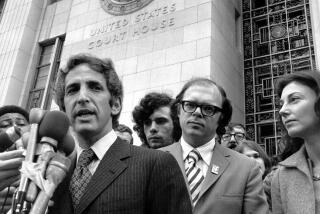THE NATION : INTELLIGENCE : Has a 30-Year Mystery Unraveled?
NEW YORK — It was soon after dark in the spring of 1968 when the car slowly pulled to a stop on Riverside Drive, just north of New York’s 122nd Street. A couple emerged and walked toward the Gothic grayness of Grant’s Tomb.
A discrete distance away, in another car, FBI agents watched as the pair, Peter and Ingeborg Fisher, turned toward the woods and disappeared. Moments later, Ingeborg reappeared, shortly followed by Peter. Three hours later, back at their home in Upper Darby, Pa., the two toasted their success.
“We did it right, didn’t we?” said Peter. “So quick, we did it so quick . . . Today we had luck.”
“Our success,” Ingeborg agreed, with a caveat. “But we are never certain.” The words must have amused the FBI agents who were listening in.
At almost that exact moment, another car pulled up to the same spot on Riverside Drive and another couple stepped outside. Artem Shokin walked into the same woods, and a few seconds later, emerged, reentered the car with his wife and drove back to their Manhattan apartment. A conga line of unseen FBI vehicles followed.
It was a classic dead drop. “Peter Fisher” was actually Gennady Petrovich Blyadlin, a Russian KGB “illegal” agent--planted in the United States but having no overt connection to the Soviet government. If arrested, there would be no diplomatic expulsion. It would be trial and possible execution. Shokin, on the other hand, was a KGB agent assigned to the United Nations under diplomatic cover as a translator.
What was passed that night has had the FBI perplexed for nearly three decades. Now they think they have an answer. Eight months earlier, in September 1967, Robert Lipka, a former soldier, had moved to Lancaster, 77 miles from the Fishers’ house, after his discharge from a three-year assignment at the headquarters of the supersecret National Security Agency. For much of his tour at NSA, according to charges filed by the Justice Department last week, Lipka spied for the KGB. And when he left, says the FBI, he took a stack of additional documents to continue his side business.
The dead drop at Grant’s Tomb, the FBI now believes, was an effort by Fisher to notify his KGB contact, Shokin, of his intention to locate and contact Lipka. Thus, about a week later, Fisher appears to have taken a trip to Lipka’s town. A secret entry by the FBI into Fishers’ house a few days later turned up a notebook that contained what appeared to be directions to a place only a few miles from Lipka’s house and the word “Roeck,” pronounced “rook” by someone who spoke German. As part of his cover as a German citizen, Fisher almost always spoke German. “Rook,” it turns out, was Lipka’s alleged code name.
Although little has been said of the potential seriousness of Lipka’s alleged espionage, the damage may have been enormous. For nearly two years, from September 1965 until August 1967, Lipka was assigned to the Priority Materials Branch of NSA’s Current Intelligence Division--the funnel through which virtually all the most secret documents, messages, cables and reports enter the NSA. This includes raw intercepts sent from the NSA’s far-flung listening posts, thick technical analysis of secret Russian communications systems delivered by military and diplomatic courier, code-word Teletype messages from the White House, Pentagon, CIA and other intelligence agencies, and crypto key cards for use on encryption equipment.
There is a troubling irony when one compares the long, difficult and dangerous route the NSA must follow with eavesdrop on critical Russian communications, to the ease with which Lipka allegedly gave much of it away. First, the agency must find the right signal, which is frequently hidden in static or bounced from frequency to frequency at a thousand times a second. Once found, huge supercomputers attempt to crack the code using “brute force”--trying every combination imaginable until a match is made. But this may give only a single word, or sentence. On rare occasions, the agency is able to recruit a code clerk in a Russian communications center who is able to photograph original cryptographic materials and pass the film on to U.S. agents. By contrast, if the Justice Department charges are true, Lipka simply took the information, stuck it under his army hat, or strapped it to his legs, and walked out of NSA headquarters.
The consequences of such espionage, if true, have the potential of being not only extremely damaging but also deadly. Once the Russians discovered the NSA had managed to intercept a particular channel or break a certain code, they could either switch to a different channel or change the code--plastering over a critical peep hole into the Kremlin’s workings and, at the same time, negating thousands of hours of work and millions of dollars of research.
But this is more preferable to a more likely outcome: Using the tapped lines to pass on huge amounts of disinformation. Knowing that the U.S. government is listening in on a particular communication link, for example, a line in and out of the Russian Navy’s sub headquarters, the Russians have the potential to wreck havoc with the Navy’s war-planning capabilities by causing designers to develop weapons that would be ineffective against Russian countermeasures. Because the Russians may have had access to much, if not all, of the NSA’s success stories during the mid-to-late 1960s, the disinformation possibilities are endless.
But the real tragedy may be in lost American lives. At the time Lipka is alleged to have given the Russians the welcome key to the NSA, the United States was engaged in the Vietnam War. Much of the information flowing in and out of Lipka’s area certainly dealt with U.S. successes against North Vietnamese military codes and the planning of dangerous U.S. airborne reconnaissance operations over enemy territory. In either case, if the Russians passed on the information to North Vietnam, many U.S. lives may have been lost. Finally, if Lipka managed to pass on original photographs of Russian cryptographic materials, it would probably not have taken long for the KGB to have found the spy, because such materials have extremely limited distribution. The consequences for the spy leave little to the imagination.
One indication of the quality of materials that may have been passed to Moscow comes from the man who ran many of the KGB’s operations against the United States, Oleg Kalugin. Although unidentified by name, the FBI believes Kalugin’s description of the “walk-in” spy, mentioned in his book, “The First Directorate,” is Lipka. The NSA soldier came to the KGB in the mid-1960s, he said, “and passed on reams of top-secret material.”
If the charges against Lipka are true, the Russians were mighty stingy when it came to paying him. It is alleged he received only about $500 a delivery of documents--about $21,000 in total. But the decision to make modest payments had little to do with balance sheets and far more to do with operational security. Incredibly, just before Lipka came along, the KGB had another Army soldier at the NSA spying for them who was doing virtually the same job.
More to Read
Sign up for Essential California
The most important California stories and recommendations in your inbox every morning.
You may occasionally receive promotional content from the Los Angeles Times.










